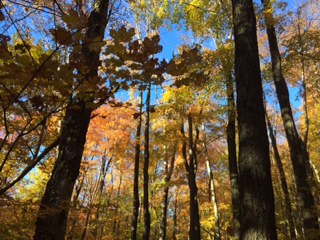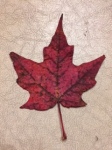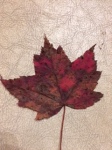 With New England’s hills ablaze in their autumn foliage, it’s impossible not to see the forest for the trees. But the forest is made up of individual trees, each of which turns a characteristic color this time of year.
With New England’s hills ablaze in their autumn foliage, it’s impossible not to see the forest for the trees. But the forest is made up of individual trees, each of which turns a characteristic color this time of year.
Generally, it’s the maples that turn scarlet and the poplars and birch that go yellow and gold. Sumac turns purple, and hobblebush burgundy. For the most part, oak stay green before rusting to brown, and they hang on to the branches long after the leaves of other trees fall.
I’ve always loved the autumnal forest, but lately, I’ve become interested in individual trees. I’m learning how to read the New England landscape in order to know it better, and to be able to hunt the white tailed deer. This weekend, I finally learned how to differentiate four types of maples by examining their leaves.

sugar maple
The sugar maple has smooth-edges between its five points, which looks to me like an open palm, like a sign of peace.

red maple
The red maple has saw-toothed edges on three major points, like a fleur-de-lys.

silver maple
The silver maple leaves are long, narrow and jagged, like a skeletal hand.

striped maple
And the leaf of the striped maple reminds me of a medieval shield, bold and protective. It on this tree that white tailed buck rub with their antlers to mark territory and to let the does know they’re around and interested.
I once had a professor who said, “Truth lies in minute particulars.” Learning to differentiate leaves requires observing the minute particulars. It’s in the details that we see difference, in details that a story becomes vivid.
Without details, we might only see the forest, and not the trees.

Over the chin of Mount Mansfield – Vermont’s highest peak
Deborah Lee Luskin divides her time between her desk, the outdoors, and www.deborahleeluskin.com

Great read! Thanks for sharing this 😊
Thanks for reading the post – and commenting!
thanks for sharing this. Great quote…..Be careful you don’t miss the forest as you focus on the trees. It the same the other way. Individuals can be great but when in unity -like the blazing colours of trees in groups – something stronger and more profound is accomplished. Thanks again .
Always nice to hear from you Faye! Thanks.
I’m a huge tree person. I find them such beautiful creatures, but I’ve never known anything about the different species. Lately I’ve been wanting to learn them, so thank you for posting this! I love it! If you recommend any books or other learning tools, I’d love to hear your input 🙂